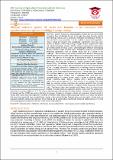| dc.description.abstract | Western Kenya faces high population pressure and this has increased
demand for food. Smallholder farmers in the region have been forced to practice
poor farming practices such as continuous cultivation and clearing of forests to
put more land to crop production. This has resulted in severe land degradation,
climate change and reduced farm productivity. Agroforestry trees have been
reported to improve soil fertility through nitrogen fixation coupled with leaves
and twig decomposition. However, this has not been ascertained in maize-banana
agroforestry systems in Vihiga County. Understanding the effects of intercropping
of maize and banana with Sesbania sesban, Calliandra calothyrsus and Leucaena
diversifolia agroforestry trees on nutrient uptake may be a remedy to the
challenges. Therefore there is need to fully understand the effects of intercropping
selected agroforestry trees with maize and banana on nutrient uptake of maize and
banana. The objective of the study was to determine the effect of intercropping
agroforestry tree species on maize and banana tissue N, P, K, Mg, Ca uptake and
partitioning. The study was conducted at Maseno university farm located in
Vihiga County. The Williams varieties of banana of the same age were obtained
from KALRO-Thika., Seeds of selected agroforestry trees were purchased from
KEFRI – Muguga, planted in a seedbed and the seedlings raised in nurseries.
Hybrid maize seed, H513 was p urchased from an agrovet. Banana holes were d ug
2x2 feet, 20 Kg of decomposed cow dung manure + 20 Kg of top soil + 200g of
NPK fertilizer added in each banana hole and banana planted. Randomized
complete block design (RCBD) with 3 replications were used with seven
treatment levels of i.e. maize, banana, maize + banana + Callian dra, maize +
banana + leucaena, maize + banana + sesbania, maize + banana, and fertilized
maize. Maize were planted at 0.75 m inter row by 0.3 m spacing. Five maize
plants per treatment and per replication were sampled randomly from the eight
middle rows at harvest and partitioned in to leaves, shoots, roots, cobs and maize
grains. Two banana plants were sampled and its leaves taken for mineral tissue
analysis. The maize roots were washed in water to remove soil. The samples wer e
oven dried to a constant weight at 72 0C. The samples were then ground into powder for determination of nutrient analysis. Procedures
by Motsara and Roy (2008) was used to determine the nitrogen, phosphorus, potassium, calcium and magnesium mineral nutrient in
various plant tissues. Data was subjected to Analysis of Variance using Genstat statistical package Version 15.2. Maize and bananas
that were intercropped with trees recorded highest nutrient uptake and partitioning. Sesbania sesban recorded higher nutrient upt ake as
compared treatments without tree intercrops. These findings can be used to advice smallholder farmers of Vihiga County on the best
intercropping system to adopt for maximum maize and banana production | en_US |

